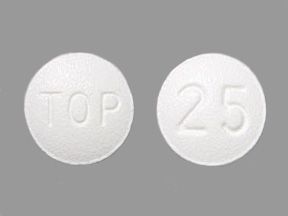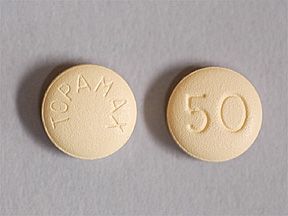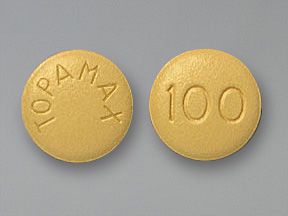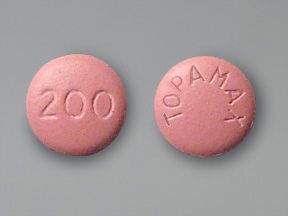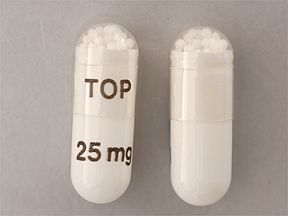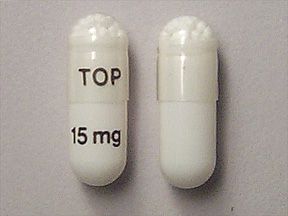Topamax (topiramate) is a brand-name drug that’s prescribed for migraine headaches and certain kinds of seizures. Topamax comes as oral tablets and capsules filled with sprinkles. It’s typically taken once or twice daily.
Topamax is FDA-approved to treat the following in adults and children ages 2 years and older:
- partial-onset seizures
- primary generalized tonic-clonic seizures
- seizures due to Lennox-Gastaut syndrome
Topamax is also approved to help prevent migraine headaches in adults and in children ages 12 years and older.
Topamax belongs to a drug class called anticonvulsants. Topamax is available in a generic version.
Keep reading for specific information about the dosage of Topamax, including its strengths and how to take it. For a comprehensive look at Topamax, see this article.
Note: This article describes typical dosages for Topamax provided by the drug’s manufacturer. When taking Topamax, always follow the dosage prescribed by your doctor.
Topamax’s dosage is different for each person. The usual dosage for treating seizures may be different than the dosage for preventing migraine headaches. Be sure to take the dosage prescribed by your doctor.
Topamax forms
Topamax comes in two forms: an oral tablet and a capsule filled with sprinkles of the active drug.
The sprinkle capsule can be swallowed whole. Or it can be opened and sprinkled onto a teaspoon of soft food and then swallowed.
Topamax strengths
Topamax tablets are available in the following strengths:
- 25 milligrams (mg)
- 50 mg
- 100 mg
- 200 mg
Topamax sprinkle capsules come in two strengths:
- 15 mg
- 25 mg
Typical dosages
Your doctor will start you on a low starting dose of Topamax. Then, they’ll increase it over time to reach the amount that’s right for you. The Topamax dosage that you’ll take long term is called your maintenance dosage. Your doctor will ultimately prescribe the smallest dosage that provides the desired effect.
The following information describes Topamax dosages that are commonly used or recommended. However, be sure to take the dosage your doctor prescribes for you.
There’s no Topamax dosage that’s considered normal or average. This is because dosing, including the highest dose, can vary from person to person. It also depends on the condition being treated. Your doctor will determine the best dose available to fit your needs.
Dosages for migraine headache prevention
For preventing migraine headaches, you’ll start treatment by taking a low dose, typically 25 mg once per evening. Then, your doctor will gradually increase your dose over the next several weeks. The table below shows a typical schedule of dose increases:
| Treatment week | Morning dose | Evening dose |
| 1 | none | 25 mg |
| 2 | 25 mg | 25 mg |
| 3 | 25 mg | 50 mg |
| 4 | 50 mg | 50 mg |
Topamax’s recommended maintenance dose is 100 mg per day (mg/day). This is taken as two 50-mg doses, one in the morning and one in the evening.
Your maximum dose of Topamax for migraine headaches is determined by your doctor. Depending on how effective Topamax is for you and other factors, your doctor may increase your dosage above 100 mg/day. In clinical trials, the highest dosage studied for migraine prevention was 200 mg/day.
Dosages for seizure treatment
Topamax is approved to treat partial-onset seizures, generalized tonic-clonic seizures, and seizures due to Lennox-Gastaut syndrome. Your dosage will vary based on whether you’re taking Topamax on its own or with another medication.
For treating partial-onset or generalized tonic-clonic seizures, your doctor may prescribe Topamax alone or with other medications for seizures.
For treating seizures due to Lennox-Gastaut syndrome, they will prescribe Topamax with other medications for treating seizures. The drug isn’t prescribed for this use on its own.
Dosages for seizure treatment when taken on its own
Typically, your doctor will start you with a low dose of 25 mg, twice per day. And they’ll gradually increase your dose over the first weeks of your treatment. The table below shows the usual schedule of dose increases:
| Treatment week | Morning dose | Evening dose |
| 1 | 25 mg | 25 mg |
| 2 | 50 mg | 50 mg |
| 3 | 75 mg | 75 mg |
| 4 | 100 mg | 100 mg |
| 5 | 150 mg | 150 mg |
| 6 | 200 mg | 200 mg |
The maintenance dosage for adults and for children ages 10 years and older is 400 mg/day. This is taken as two 200-mg doses, one in the morning and one in the evening.
Dosages for seizure treatment when taken with other medications
For adults and for children ages 17 years and older, the starting dose is 25 to 50 mg/day.
The dose is then increased in amounts of 25 to 50 mg/day every week until the most effective dose is reached. The recommended total daily doses are:
- 200 to 400 mg/day for partial-onset seizures or seizures caused by Lennox-Gastaut syndrome
- 400 mg/day for primary generalized tonic-clonic seizures
The above dosages are taken as two doses, one in the morning and one in the evening.
Children’s dosages
Children’s Topamax dosages are based on body weight. They also depend on the child’s age and which condition is being treated.
Dosages for migraine headache prevention in children ages 12 years and older
Topamax can be used to help prevent migraine headaches in children ages 12 years and older. The dosage for this use is the same as the adult dosage. See the “Dosage for migraine headache prevention” section above.
Dosages when taken on its own for seizure treatment in children ages 2 years and older
The dosage of Topamax for treating seizures in children depends on whether Topamax is taken on its own or with other medications.
Dosages when used on its own for seizures in children ages 2 to 9 years
Topamax can be taken on its own to treat partial-onset and generalized tonic-clonic seizures in children ages 2 to 9 years.
Below is Topamax’s starting dosage for seizures in children ages 2 to 9 years:
- Week 1: The dosage will be 25 mg once per evening.
- Week 2: The dosage will likely be increased to 25 mg in the morning and 25 mg in the evening.
- Weeks 3 to 7: The total daily dose may be increased in amounts of 25 to 50 mg/day as needed each week.
The doctor will start your child on a low dosage of Topamax. They may increase your child’s pediatric dose based on how well the current dose is working. They’ll also consider whether or not your child experienced severe or bothersome side effects. If your child isn’t having these types of side effects, their doctor may continue to increase their dose to reach a maintenance dose. This is based on body weight in kilograms (kg). (One kg is about 2.2 pounds [lb].)
Your child’s doctor may continue to increase their dose to the highest maintenance dosage as shown in the table below:
| Weight | Lowest maintenance dosage | Highest maintenance dosage |
| up to 11 kg (up to about 5 lb) | 150 mg/day | 250 mg/day |
| 12 to 22 kg (about 5.4 to 10 lb) | 200 mg/day | 300 mg/day |
| 23 to 31 kg (about 10.4 to 14 lb) | 200 mg/day | 350 mg/day |
| 32 to 38 kg (about 14.5 to 17.2 lb) | 250 mg/day | 350 mg/day |
| over 38 kg (over about 17.2 lb) | 250 mg/day | 400 mg/day |
Dosages of Topamax when used on its own for seizures in children ages 10 years and older
To treat partial-onset and generalized tonic-clonic seizures in children ages 10 years and older, the adult dosage is used. See the “Dosages for seizure treatment when taken on its own” section above for more information.
Dosages for seizure treatment when taken with other medications in children ages 2 to 16 years
When Topamax is taken with other seizure medications in children ages 2 to 16 years,* the dosage is based on body weight. It’s also adjusted over time.
For the first week of treatment, the highest possible starting dose is 25 mg/day, taken in the evening. Your child’s individual dose will be 1 to 3 mg of Topamax per kg of body weight (mg/kg), up to the maximum of 25 mg/day. The dose will then be increased by a daily total of 1 to 3 mg/kg. It’s likely that your child’s doctor will change the dose from once daily in the evening to twice daily. This total daily dose will be split equally, with one in the morning and one in the evening.
The recommended maintenance dosage is 5 to 9 mg/kg per day. This daily dose is divided into two doses, with one in the morning and one in the evening. The maximum total daily dose is 400 mg/day.
* Children who are 17 years and older receive the same dose as adults. For more information, see the “Dosages for seizure treatment when taken with other medications” section above.
Long-term use
Topamax is meant to be used as a long-term treatment. If you and your doctor determine that Topamax is safe and effective for you, you’ll likely take it long term.
Below are some common questions about Topamax.
I accidentally took a double dose of Topamax. What should I do?
You should contact your doctor right away or go to the nearest emergency room or hospital if you have symptoms that are severe or life threatening. It’s not recommended to take more Topamax than your doctor prescribes. Taking too much Topamax may lead to serious side effects. See the “Topamax and overdose” section below for details.
Is Topamax prescribed to treat sleep problems? If so, what’s its dosage?
It depends. Topamax isn’t approved for treating sleep problems. So, there’s no recommended dosage of Topamax for this use. It’s only approved to treat certain types of seizures and to help prevent migraine headaches in adults and some children.
A small study found that topiramate (the active drug in Topamax) helped treat symptoms of sleep-related eating disorder (SRED). While Topamax isn’t approved to treat SRED, it may be prescribed off-label for this condition. Off-label drug use means using a drug for a purpose other than what it’s been approved for by the Food and Drug Administration (FDA).
Topamax can also cause sleepiness as a side effect. (For more information about side effects with Topamax, see this article.)
If you have trouble sleeping or have questions about taking Topamax for sleep problems, talk with your doctor.
Can Topamax be taken for nerve pain? If so, what’s the dosage for this use?
It depends. Topamax isn’t approved for nerve pain or trigeminal neuralgia. There’s no known maximum dosage for nerve pain since the drug isn’t approved for this use.
However, Topamax may be prescribed off-label for treating nerve pain, such as trigeminal neuralgia. In small
If you have questions about treatment for nerve pain or off-label uses of Topamax, talk with your doctor.
Is Topamax used for weight loss? If so, what’s the dosage for this purpose?
It depends. Topamax isn’t approved for weight loss. There’s no maximum dose of Topamax for weight loss since the drug isn’t approved for this use.
However, topiramate may be prescribed off-label for weight loss. Topiramate is the active drug in Topamax. Several
Also, a drug called Qsymia is approved for long-term weight management in adults. Qsymia contains the active drugs topiramate and phentermine. You can read more about Qysmia in this article.
It’s important to take Topamax as prescribed by your doctor. And if you have questions about your weight while taking Topamax, your doctor can help. They can also answer any questions you have about off-label uses of Topamax and other drugs used for weight management.
Missing a dose of Topamax isn’t known to cause side effects. However, missing a dose of Topamax may cause you to have symptoms of the condition you’re taking it to treat. (For more information on conditions that Topamax is used to treat, see this article.)
If you miss a single dose of Topamax, take it as soon as you remember. If you’re scheduled to take your next dose within 6 hours, skip the missed dose and take your next dose as usual. You should not double up on doses.
To help make sure that you don’t miss a dose, try using a medication reminder. This can include setting an alarm or using a timer. You could also download a reminder app on your phone.
The Topamax dosage your doctor prescribes will depend on several factors. These include:
- the type and severity of the condition you’re taking Topamax to treat
- the form of Topamax you take
- your age
- body weight, for children
- your renal (kidney) function
Other medical conditions you have can also affect your Topamax dosage.
Dosage adjustments
Your doctor may adjust your Topamax dosage if you:
- have limited kidney function
- are having hemodialysis treatment
You should take Topamax exactly as directed by your doctor.
If you’re prescribed Topamax tablets, be sure to swallow them whole. Do not crush or chew them. If you have trouble swallowing pills, talk with your doctor or check out this article. Your doctor may prescribe Topamax sprinkle capsules instead of tablets.
Topamax sprinkle capsules can be swallowed whole or opened. If it’s easier for you, the sprinkles can be added to a teaspoon of soft food, such as applesauce. Be sure to consume this immediately. You should not chew the sprinkles.
Also, you shouldn’t prepare doses with food ahead of time. This can affect how the drug is absorbed by the body and prevent you from getting your dose as prescribed. After taking the sprinkles, you should drink a beverage, such as water, to make sure that you swallow all of them.
It’s important that you do not take more Topamax than your doctor recommends. If you take more Topamax than your doctor prescribes, you may develop serious side effects.
Symptoms of an overdose
Symptoms of a Topamax overdose can include:
- convulsions (jerky muscle movements)
- fatigue
- trouble speaking or with speech
- double or blurred vision
- problems thinking clearly
- coordination problems
- fainting
- low blood pressure
- abdominal pain
- feeling agitated
- dizziness
- feeling sad or depressed
If you take more than the recommended amount of Topamax
Call your doctor right away if you believe you’ve taken too much Topamax. Another option is to call America’s Poison Centers at 800-222-1222 or use its online tool. If you have severe symptoms, immediately call 911 (or your local emergency number) or go to the nearest emergency room.
Topamax isn’t known to cause dependence or withdrawal. (With dependence, the body needs the drug to function as it typically does. And with withdrawal, a person may experience side effects after stopping a drug that their body has become dependent on.)
However, you should not stop taking Topamax suddenly. If you’re taking Topamax for seizure treatment, stopping the drug could cause a seizure. And if you’re taking Topamax to help prevent migraine headaches, your risk of having a migraine episode may increase if you suddenly stop taking the drug.
If you want to stop Topamax, talk with your doctor. They can discuss how to gradually stop taking the drug.
The dosages in this article are typical dosages provided by the drug manufacturer. If your doctor recommends Topamax for you, they will prescribe the dosage that’s right for you. Always follow the dosage that your doctor prescribes for you.
As with any drug, never change your dosage of Topamax without your doctor’s recommendation. If you have questions about the dosage that’s right for you, talk with your doctor.
Besides learning about dosage, you may want other information about Topamax. These additional articles might be helpful to you:
- More about Topamax. For information about other aspects of Topamax, refer to this article.
- Side effects. To learn about side effects of Topamax, see this article. You can also look at the Topamax prescribing information.
- Interactions. For details about what Topamax interacts with, see this article.
- Details about your condition:
- For details about migraine, see our migraine hub as well as these related articles. You can also learn more about Topamax and migraine prevention in this article.
- For more information about epilepsy, see our epilepsy and seizure hub or these articles.
Disclaimer: Medical News Today has made every effort to make certain that all information is factually correct, comprehensive, and up to date. However, this article should not be used as a substitute for the knowledge and expertise of a licensed healthcare professional. You should always consult your doctor or another healthcare professional before taking any medication. The drug information contained herein is subject to change and is not intended to cover all possible uses, directions, precautions, warnings, drug interactions, allergic reactions, or adverse effects. The absence of warnings or other information for a given drug does not indicate that the drug or drug combination is safe, effective, or appropriate for all patients or all specific uses.

